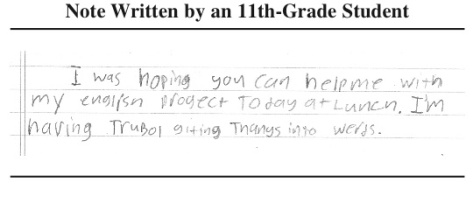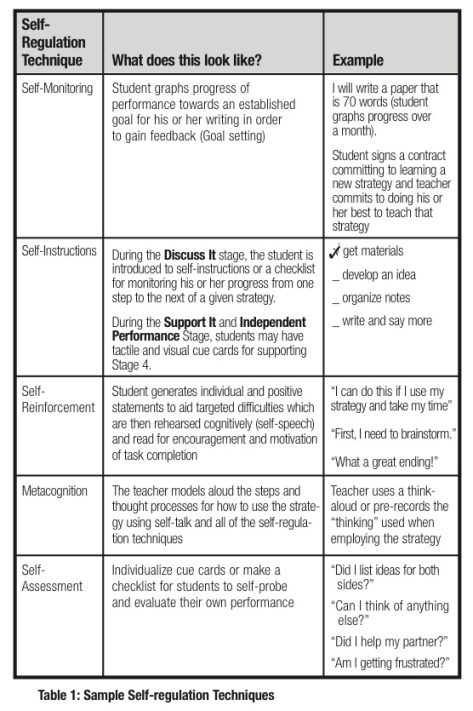This post describes a writing strategy for course participants in the MOOC Helping History Teachers Become Writing Teachers that will take place between January 12, 2015 – February 24, 2015. Regardless of if you are participating in the course or not, feel free to make comments, or click on the links for the original sources. 
Integrating Self Regulated Strategy Development (SRSD) into History/Social Science writing instruction is not taught in many teacher credentialing programs, nor is it offered in professional development seminars. Long used in elementary and middle schools to help students with Learning Disabilities (LD), SRSD is now being used with English Language Learners (ELLs) in some high schools. More than 40 studies have validated SRSD as an instructional model for teaching writing to students with writing deficits. Developed by Harris & Graham (1992), this model integrates writing instruction, self-regulation strategies, and the development of positive student attitudes toward writing.  Writing Strategies All SRSD writing strategies contain mnemonics for learning strategy steps. For instance, the narrative, or storytelling strategy utilizes POW. Each letter represents a step (a) Pick my idea; (b) Organize my notes; and (c) Write and say more. SRSD considers writing a problem-solving task requiring planning, knowledge, and skills. Planning includes pre-writing, drafting, and revising the essay.
Writing Strategies All SRSD writing strategies contain mnemonics for learning strategy steps. For instance, the narrative, or storytelling strategy utilizes POW. Each letter represents a step (a) Pick my idea; (b) Organize my notes; and (c) Write and say more. SRSD considers writing a problem-solving task requiring planning, knowledge, and skills. Planning includes pre-writing, drafting, and revising the essay.
Step 1 – Develop background knowledge. Increasing background knowledge. Purpose of writing. What skills are needed to achieve a writing goal?
Step 2 – Discuss it. The role of student effort in learning the strategy. The self-regulation procedures. Self-monitoring. identifying reasonable, measurable, and attainable goals.
Step 3 – Model it. Teachers model is completed. Students are taught how to count all the essay parts to determine whether all aspects of the prompt are answered in the essay. (Deconstructing prompt, Do-What chart).
Step 4 – Memorize it. Students practice the steps of the strategy. Meaning of mnemonics used to reinforce fluency. Teachers provide students with cue cards (described above), common think sheets, planning sheets, and graphic organizers. Reminders of the critical steps involved in writing compositions.
Step 5 – Support it. Teachers provide scaffolding and continuous feedback while students practice writing. Teachers may work collaboratively with the students following all of the planning and organizing steps. As students begin to master the essay writing process, scaffolds are removed. Step 6 – Independent Performance. Students write independently without graphic organizers. They user fewer audible self-statements, because they have internalized the strategy. 
Self Regulation Strategies
Self-regulation refers to self-initiated thoughts, feelings, and actions that writers use to meet literary goals. When writers use self-regulation, they control their environment and behavior, including the time spent writing and organizing their ideas. Self-regulating writers develop goal-setting strategies, task-analyzing objectives, and self-reinforcement. Additional self-regulation techniques include: self-monitoring, self-instructions, self-reinforcement, metacognition, and self-assessment. Further techniques are embedded into each of the six stages of SRSD writing.
Development of positive attitudes toward writing
Environments that are supportive and pleasant develop students’ passion for writing and increase the odds that they will apply SRSD strategies. A few ways to create an inspiring classroom include: (1) establishing an exciting mood during writing time; (2) encouraging students to take risks when writing; (3) developing writing assignments that reflect students’ interests; (4) allowing students to select their own writing topics or modify assigned topics; (5) having students arrange their own writing space; and (6) encouraging students to help each other as they plan, write, and revise.
Additional Resources An outstanding tutorial on SRSD can be found at the IRIS Center for Training Enhancements. http://iris.peabody.vanderbilt.edu/module/srs/ The Power of SRSD https://www.youtube.com/watch?v=BHTvJFaINqI SRSD PD https://www.youtube.com/watch?v=D0mw73aO9_k Kristy Currie – SRSD https://www.youtube.com/watch?v=czNaUbeAZnA Modeling Story Writing https://www.youtube.com/watch?v=4-zVG38kBcU TIDE Mnemonic https://www.youtube.com/watch?v=atBZUnyOnmI Long Lecture – thinkSRSD https://www.youtube.com/watch?v=QylROcPEDC8 Steve Graham bonus video https://www.youtube.com/watch?v=nIxxSJ3pG_M
References
Regan, K., & Mastropieri, M.A. (2009) Current Practice Alerts: A focus on Self Regulated Strategy Development for Writing. Issue 17, Spring, 2009. Division for Learning Disabilities (DLD) and Division for Research (DR) of the Council for Exceptional Children. http://www.teachingld.org.
Santangelo, T., Harris, K.R., and Graham, S. (2008). Using Self-Regulated Strategy Development to Support Students Who Have “Trubol Giting Thangs Into Werds”. Remedial and Special Education. Vol. 29, No. 2. March/April 2008. 78-89. DOI: 10.1177/0741932507311636
Mnemonics work: take PEMDAS, for instance. But, to work effectively, the background knowledge has to be there; this very day, I mentioned PEMDAS to one of my 11th-grade economics students, and when I followed up her blank stare with “You know, order of operations and all that,” the stare went from blank to horrified. The article addresses this in Step 1, but I think this has to begin long before the student crosses my threshold.
That caveat aside, I particularly like the PLANWRITE approach to composing essays, which I have encountered somewhere in the past and deployed in my classrooms. The fly in that unguent jar is persuading students to go through the labors of actually planning an essay (I prefer the term mapping, but it is the same idea). For some reason, young people don’t like to plan anything at all.
I would really, truly, absolutely love for middle and high schools to have mandatory effective writing courses, the secondary equivalent of freshman composition, in which these SRSD techniques were taught. We offered one last year, and the students who took it and then came to my dual credit course wrote much better than those who had not. The course was eliminated this year as being “unnecessary.” Please, give me a break.
My final thought is a concern: this all seems rather time intensive. I have my American History students 42 minutes a day for, on average, three days a week in a 132-day academic year (testing, events and assemblies, pre-planned absences, etc.). I am expected to cover American history from 1877 to present day. How do I make it all work together?
LikeLike
Great comment, Henry. I hope the new accountability tests will allow students to select an era they are passionate about and have them demonstrate their historical writing skills, instead of requiring 80 multiple-choice questions to assess depth and range of knowledge. We need to get off the standards coverage treadmill.
LikeLike
Thank you for this insightful and well-done explanation of SRSD, which is becoming more evident in high schools. Henry, your concern is quite valid, and we need to work to make this possible. However, it become less time intensive once you have used it, and ELA teachers should be teaching validated strategies using SRSD too! Karen Harris
LikeLiked by 1 person